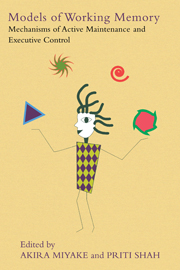Book contents
- Frontmatter
- Contents
- List of Contributors
- Dedication
- Preface
- Ode on Working Memory
- Acknowledgments
- 1 Models of Working Memory: An Introduction
- 2 Working Memory: The Multiple-Component Model
- 3 An Embedded-Processes Model of Working Memory
- 4 Individual Differences in Working Memory Capacity and What They Tell Us About Controlled Attention, General Fluid Intelligence, and Functions of the Prefrontal Cortex
- 5 Modeling Working Memory in a Unified Architecture: An ACT-R Perspective
- 6 Insights into Working Memory from the Perspective of the EPIC Architecture for Modeling Skilled Perceptual-Motor and Cognitive Human Performance
- 7 The Soar Cognitive Architecture and Human Working Memory
- 8 Long-Term Working Memory as an Alternative to Capacity Models of Working Memory in Everyday Skilled Performance
- 9 Interacting Cognitive Subsystems: Modeling Working Memory Phenomena Within a Multiprocessor Architecture
- 10 Working Memory in a Multilevel Hybrid Connectionist Control Architecture (CAP2)
- 11 A Biologically Based Computational Model of Working Memory
- 12 Models of Working Memory: Eight Questions and Some General Issues
- 13 Toward Unified Theories of Working Memory: Emerging General Consensus, Unresolved Theoretical Issues, and Future Research Directions
- Name Index
- Subject Index
12 - Models of Working Memory: Eight Questions and Some General Issues
Published online by Cambridge University Press: 05 June 2012
- Frontmatter
- Contents
- List of Contributors
- Dedication
- Preface
- Ode on Working Memory
- Acknowledgments
- 1 Models of Working Memory: An Introduction
- 2 Working Memory: The Multiple-Component Model
- 3 An Embedded-Processes Model of Working Memory
- 4 Individual Differences in Working Memory Capacity and What They Tell Us About Controlled Attention, General Fluid Intelligence, and Functions of the Prefrontal Cortex
- 5 Modeling Working Memory in a Unified Architecture: An ACT-R Perspective
- 6 Insights into Working Memory from the Perspective of the EPIC Architecture for Modeling Skilled Perceptual-Motor and Cognitive Human Performance
- 7 The Soar Cognitive Architecture and Human Working Memory
- 8 Long-Term Working Memory as an Alternative to Capacity Models of Working Memory in Everyday Skilled Performance
- 9 Interacting Cognitive Subsystems: Modeling Working Memory Phenomena Within a Multiprocessor Architecture
- 10 Working Memory in a Multilevel Hybrid Connectionist Control Architecture (CAP2)
- 11 A Biologically Based Computational Model of Working Memory
- 12 Models of Working Memory: Eight Questions and Some General Issues
- 13 Toward Unified Theories of Working Memory: Emerging General Consensus, Unresolved Theoretical Issues, and Future Research Directions
- Name Index
- Subject Index
Summary
What have we learned about working memory from the 10 models described in this volume (Chapters 2 to 11)? What answers have these models provided for each of the eight questions raised by the editors (Shah & Miyake, Chapter 1), and how do these answers relate to one another? Do seemingly different answers given to the same question really reflect some fundamental differences between the models, or should they be regarded as a difference in emphasis? More generally, how well have these models, as a whole, addressed each of the eight designated questions? Although the answers to these questions can ultimately be obtained by a critical reading of the chapters themselves and careful reflections on these theoretical issues, we hope to help readers with this task by providing systematic, issue-by-issue comparisons among the models of working memory covered in this volume. To this end, we will first analyze and comment on the answers provided by the contributors for each of the designated questions. We will then raise and discuss some general issues that transcend the specific questions.
Analyses of the Answers Provided to the Eight Designated Theoretical Questions
Question 1: Basic Mechanisms and Representations in Working Memory
The first question asked the contributors to outline their view of three mechanisms that provide a basis for working memory processes – the encoding, maintenance, and retrieval mechanisms. The question also asked the contributors to specify their assumptions about the nature of working memory representations.
- Type
- Chapter
- Information
- Models of Working MemoryMechanisms of Active Maintenance and Executive Control, pp. 412 - 441Publisher: Cambridge University PressPrint publication year: 1999
- 19
- Cited by



